PRE-HISTORIC ROCK ART
In India the earliest paintings have been reported from the Upper Palaeolithic times. The first discovery of rock paintings was made in India in 1867–68 by an archaeologist, Archibold Carlleyle in Sohahighat, UP.
Remnants of rock paintings have been found on the walls of the caves situated in several districts of Madhya Pradesh, Uttar Pradesh, Andhra Pradesh, Karnataka and Bihar. Some paintings have been reported from the Kumaon hills in Uttarakhand also.
The paintings here can be divided into three categories: man, animal and geometric patterns in white, black and red ochre.
- The subjects depicted are bulls, elephants, sambhars, gazelles, sheep, goats, horses, stylised humans, tridents, but rarely, vegetal motifs.
- The richest paintings are reported from the Vindhya ranges of Madhya Pradesh and their Kaimurean extensions into Uttar Pradesh.
Bhimbetka
- Among these the largest and most spectacular rock-shelter is located in the Vindhya hills at Bhimbetka in Madhya Pradesh.
- Bhimbetka has yielded about eight hundred rock shelters, five hundred of which bear paintings.
- The caves of Bhimbetka were discovered in 1957–58 by eminent archaeologist V.S. Wakankar and later on many more were discovered.
- The themes of paintings include mundane events of daily life and hunting scenes.
Mesolithic Rock Art
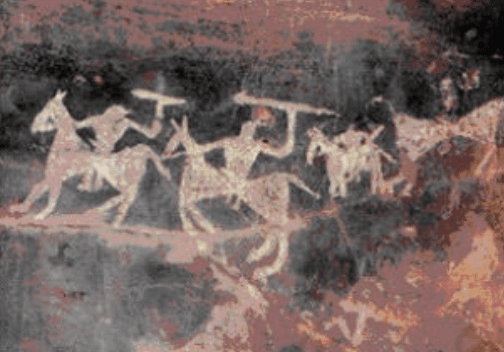
- The largest number of paintings belong the Mesolithic period.
- During this period the themes are multiple but the paintings are smaller in size.
- Hunting scenes predominate.
- Elephant, bison, tiger, boar, deer, antelope, leopard, panther, rhinoceros, fish, frog, lizard, squirrel and at times birds are also depicted.
- Though animals were painted in a naturalistic style, humans were depicted only in a stylistic manner.
- These prehistoric paintings help us to understand about early human beings, their lifestyle, their food habits, their daily activities and, above all, they help us understand their mind—the way they thought.
- Prehistoric period remains are a great witness to the evolution of human civilisation, through the numerous rock weapons, tools, ceramics and bones.
MURALS ; FRESCOES
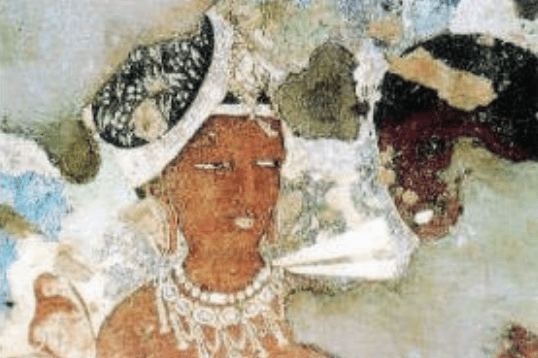
- Murals are large works executed on the walls of solid structures, as in the Ajanta Caves and the Kailashnathtemple.
- Miniature paintings are executed on a very small scale for books or albums on perishable material such as paper and cloth.
- Fresco is a technique of mural painting executed upon freshly laid lime plaster.
- This implies that the Fresco is done on wet plaster and that is why it is more durable work than Mural.
- Murals are painted on already dried surfaces.
- The early murals of India were painted by guilds of painters.
- The themes were Buddhist, Jain and Hindu.
AJANTA CAVES
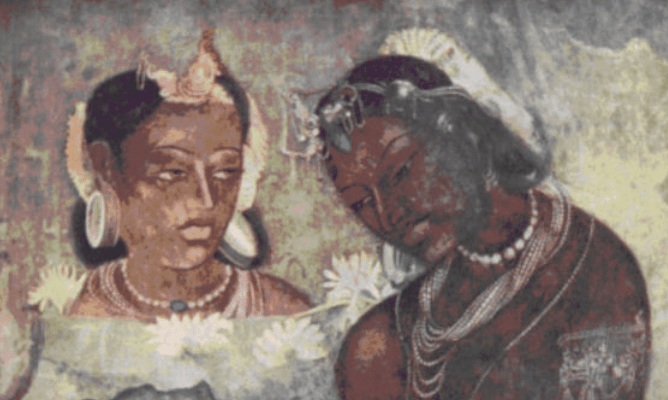
- The chaitya Cave Nos. 19 and 26 are elaborately carved.
- Their facade is decorated with Buddha and, Boddhisattva images.
- Cave No. 26 is very big and the entire interior hall is carved with a variety of Buddha images, the biggest one being the Mahaparinirvana image.
- Among the important patrons at Ajanta were Varahadeva (patron of Cave No. 16), the prime minister of the Vakataka king, Harishena.
- Upendragupta (patron of Cave Nos. 17–20) the local king of then region and feudatory of the Vakataka king, Harishena.
- The themes of the paintings are the events from the life of the Buddha, the Jatakas and the Avadanas.
- Some paintings such as Simhala Avadana, Mahajanaka Jataka and Vidhurpundita Jataka cover the entire wall of the cave.
- It may be observed that the images of Padmapaniand Vajrapani are very common in Ajanta.
- The Padmapani, the Bearer of the Lotus. This gentle figure is one of the masterpieces of Indian art.
- The Vajrapani, the Bearer of the Thunderbolt. The glorious figure portrays the majesty of the spirit.
ELLORA CAVES
- There are twelve Buddhist caves having many images belonging to Vajrayana Buddhism like Tara, Mahamayuri, Akshobhya, Avalokiteshwara, Maitrya, Amitabha, etc.
- Buddhist caves are big in size and are of single, double and triple storeys.
- Ajanta also has excavated double-storeyedcaves but at Ellora, the triple storey is a unique achievement.
- The shrine Buddha images are big in size; they are generally guarded by the images of Padmapani and Vajrapani.
- Cave No. 12, which is a triple-storey excavation, has images of Tara, Avalokiteshwara and the images of Vairochana, Akshobhya, Ratnasambhava, Amitabha, Amoghsiddhi, Vajrasatva and Vajraraja.
- On the other hand, the only double-storey cave of the Brahmanical faith is Cave No. 14.
- The Brahmanical Cave Nos. 13–29 have many sculptures.
- The images of both Shiva and Vishnu and their various forms according to Puranic narrative are depicted.
- Among the Shaivite themes, Ravana shaking Mount Kailash, Andhakasurvadha, Kalyanasundara are profusely depicted whereas among the Vaishnavite themes, the different avatars of Vishnu are depicted.
- Various guilds at Ellora came from different places like Vidarbha, Karnataka and Tamil Nadu and carved the sculptures.
- Cave No. 16 is known as Kailash leni. A rock-cut temple has been carved out of a single rock, a unique achievement of the artisans.
- The plan of Cave No. 29 is almost like that of the main cave at Elephanta.
CAVE PAINTINGS AT BAGH
- The Bagh Caves, consisting of Buddhist mural paintings, are located in Madhya Pradesh.
- These rock-cut cave monuments are not natural but carved over a period of time during the ancient India mostly during the Satvahanaperiod.
- Out of the original nine caves, only five have survived, all of which are viharas or resting places for monks.
- Most significant of the five caves is Cave No. 4, commonly known as the Rang Mahal, meaning the Palace of Colours, where paintings on the wall and ceilings are still visible.
PAINTINGS AT BADAMI
- Badami is in the State of Karnataka.
- Badami was the capital of the early Chalukyan dynasty which ruled the region from 543 to 598 CE.
- The Chalukya king, Mangalesha, patronised the excavation of the Badami caves.
- He was the younger son of the Chalukya king, Pulakesin I, and the brother of Kirtivarman I. .
- The most surviving murals include the paintings of Shiva and Parvathi as well as some other characters.
- The painting style is close with that in Ajanta.
- The Cave number 4 has a mural painting of Adinatha, the Jain tirthankara.
PALLAVA PAINTINGS
- The Pallava kings who succeeded the Chalukya kings in parts of South India, were also patrons of arts.
- Mahendravarma I who ruled in the seventh century was responsible for building temples at Panamalai, Mandagapattuand Kanchipuram.
- The inscription at Mandagapattu mentions Mahendravarman I with numerous titles such as Vichitrachitta (curious-minded), Chitrakarapuli (tiger among artists), Chaityakari (temple builder), which show his interest in art activities.
- The paintings in these temples too were done at his initiative, though only fragments remain.
- The Panamalai figure of a female divinity is drawn gracefully.
- Paintings at the Kanchipuram temple were patronised by the Pallava king, Rajsimha.
PANDYAS PAINTINGS
- When the Pandyas came to power, they too patronisedart.
- Tirumalaipuram caves and Jaina caves at Sittanvasalare some of the surviving examples.
- A few fragmented layers of paintings can be seen in Tirumalaipuram.
- In Sittanavasal, the paintings are visible on the ceilings of shrines, in verandas, and on the brackets.
- On the pillars of the veranda are seen dancing figures of celestial nymphs.
- Their eyes are slightly elongated and at times protrude off the face.
- This feature is observed in many subsequent paintings in the Deccan and South India.
CHOLA PAINTINGS
- The tradition of building temples and embellishing them with carvings and paintings continued during the reign of the Chola kings who ruled over the region from the ninth to the thirteenth century.
- But it was in the eleventh century, when the Cholas reached their zenith of power, that masterpieces of the Chola art and architecture began to appear.
- The temples of Brihadeswara at Thanjavur and Darasuram in Tamil Nadu were built during the reigns of Rajaraja Chola and Raja raja Chola II, respectively.
- With the decline of power of the Choladynasty in the thirteenth century, the Vijayanagara Dynasty (fourteenth-sixteenth centuries) captured and brought under its control the region from Hampi to Trichy with Hampi serving as its capital.
- Many paintings survive in a number of temples.
- The paintings at Tiruparakundram, near Trichy, done in the fourteenth century represent the early phase of the Vijayanagara style.
VIJAYNAGAR PAINTINGS
- In Hampi, the Virupaksha temple has paintings on the ceiling of its mandapa narrating events from dynastic history and episodes from the Ramayana and the Mahabharata.
- Among the important panels are the ones which show Vidyaranya, the spiritual teacher of BukkaRaya I, being carried in a palanquin in a procession and the incarnations of Vishnu.
- In Lepakshi, near Hindupur, in present Andhra Pradesh, there are glorious examples of Vijayanagara paintings on the walls of the Shiva temple.
KERALA PAINTINGS
- Kerala painters (during the period from the sixteenth to the eighteenth century) evolved a pictorial language and technique of their own while discriminately adopting certain stylistic elements Vijayanagara school.
- The painters evolved a language taking cues from contemporary traditions, like Kathakali and kalamezhuthu (ritual floor painting of Kerala), using vibrant and luminous colours, representing human figures in three-dimensionality.
- Most of the paintings are seen on the walls of shrines and cloister walls of temples and some inside palaces.
MINIATURE PAINTINGS
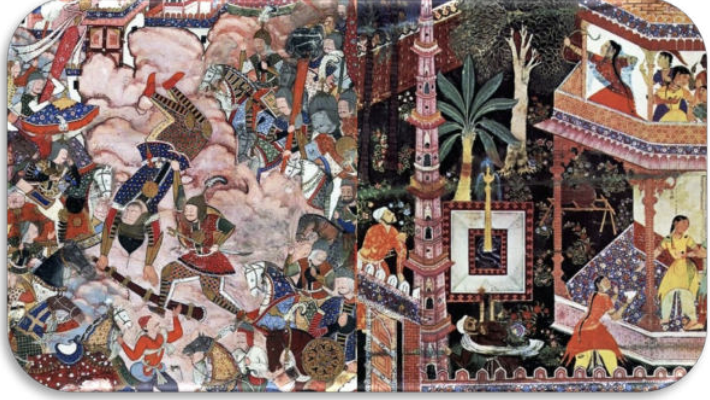
- Miniature paintings are executed on a very small scale for books or albums on perishable material such as paper and cloth.
- In India, the Pala miniature paintings are the earliest evidences of miniature painting tradition.
- In due course of time, the different schools of miniature painting emerged in different geographical locations across the country.
MINIATURE PAINTINGS
- The 10th century illustrated Buddhist text, Prajnaparamita, is the earliest known example of painting where a canvas of micro, or miniature size made its debut.
- However, the golden period for miniature paintings was the 16th century when various schools of paintings were provided patronage by the Mughals, rulers of Deccan and Malwa, and Hindu chieftains of Rajasthan.
- This led to the development of important schools of paintings such as Mughal, Rajput and Deccan schools.
MUGHAL SCHOOL OF PAINTINGS
- The school originated in the reign of Akbar.
- The origin of Mughal style is was a result of synthesis of indigenous Indian style of painting and the Safavid school of Persian painting.
- Mughal paintings were a unique blend of Indian, Persian and Islamic styles.
The major features of Mughal Schools are:
- Paintings based upon close observation of nature
- Fine and delicate drawing along with calligraphic text descriptions, generally on border.
- High aesthetic merit Primarily aristocratic
- Mostly Secular
DEVELOPMENT OF MUGHAL SCHOOL OF PAINTINGS UNDER AKBAR
The reign of Akbar is known for the initial works of Mughal School done by Mir Sayyed Ali and Abdu’s Samad Khan. These two artists were originally employed by Humayun.
The two most celebrated works accomplished during the times of Akbar was:
- Tuti-nama and
- Hamza Nama.
TUTI-NAMA
- Tuti-nama seems to be the first work of the Mughal School.
- Tuti-Nama literally means the “Tales of a Parrot”.
- The parrot tells the 52 stories in the consecutive 52 nights and in these stories, he teaches some moral stories to his owner.
- The work was completed in a span of five years under Mir Sayyid Ali and AbdusSamad.
- The text was written by Nakhshabi, an ethnic Persian physician and a Sufi saint who had migrated to Badayun.
- It was written in Persian.
MUGHAL SCHOOL UNDER JAHANGIR
- Under Jahangir, the Mughal school paintings acquired greater charm, refinement and dignity.
- The emperor Jahangir had a great fascination for nature and took delight in the portraiture of birds, animals and flowers.
- Some illustrated manuscripts of Jahangir’s time are animal fable book titled Ayar-i-Danish, Anwar-i-sunavli.
- Most of the paintings created during the time of Jahangir depict the durbar scenes, portraits, bird, animal and flower studies.
- Aqa Riza, Abul Hasan, Mansur, Bishan Das, Manohar, Goverdhan, Balchand, Daulat, Mukhlis, Bhim and Inayat were the famous painters in the court of Jahangir.
USTAD MANSUR
Ustad Mansur was a court artist of Jehangir, who specialized in depicting plants and animals. He is best known for two paintings one of which was a siberian crane and another was of a Bengal Florican.
He is also remembered for a famous painting on Dodo, the now extinct Bird.
BISHANDAS
Bishandas was praised by the emperor as “unrivalled in the art of portraiture”. In 1613, Bishandas was sent on a diplomatic mission to Persia, to paint the Shah’s portrait.
DECCANI SCHOOLS OF PAINTINGS
- The turbulent medieval times saw an exodus of artists to the South.
- The miniature painting style, which flourished initially in the Bahmani court and later in the courts of Ahmadnagar, Bijapur and Golkonda, is popularly known as the Deccan school of Painting.
NOTABLE WORKS / SUB-SCHOOLS
AHMEDNAGAR PAINTING:
- This school was patronized by Hussain Nizam Shah I of Ahmednagar
- The earliest examples of the Ahmednagar painting are contained in a volume of poems written in praise of Hussain Nizam Shah I of Ahmednagar (1553-1565) and his queen.
- This manuscript is known as the ’Tarif-in-Hussain Shahi.
- Some other fine examples of the Ahmednagar painting are the "Hindola Raga" of about 1590 A.D. and portraits of Burhan Nizam Shah II of Ahmednagar (1591-96 A.D.) and of Malik Amber of about 1605 A.D.
BIJAPUR PAINTINGS:
- The patrons of the Bijapur paintings were the Adil Shahi rulers.
- Important and notable work is Najum-al-ulum (Stars of Sciences), which has as many as 876 miniature illustrations.
- It was illustrated in 1570 A.D. in the reign of Ali AdilShah I.
- These paintings show profuse use of gold colour, some flowering plants and arabesques on the top of the throne, derived from the Persian tradition.
- Some paintings of Bijapur show influence of Lepakshitemple Murals, particularly in the depiction of the women.
GOLCONDA PAINTINGS:
- It was patronized by the Qutub Shahi rulers.
- The earliest paintings identified as Golconda work are a group of five charming paintings of about 1590 A.D., painted in the period of Muhammad Quli Shah (1580-1611) Golconda.
- They show dancing girls entertaining the company.
- Other outstanding example of the Golconda painting are "Lady with the Myna bird", about 1605 A.D., an illustrated manuscript of a Sufi poem (1605-15 A.D.) in the British Museum, London.
HYDERABAD STYLE:
- The paintings in Hyderabad style developed after the foundation of Asafjahi dynasty by Chin Qulick Khan, Nizam-ul-Mulk in 1724.
- One example is a painting of “princes in the company of maids”.
- Typical characteristics of the Hyderabad painting like the rich colours, the Deccani facial types and costumes can be observed in the miniature.
- It belongs to the third quarter of the 18th century
RAJASTHAN AND CENTRAL INDIA
- New schools of painting originated in Rajasthan and central India in the 17th and 18th centuries. Their themes included depictions from the Ramayana., the Mahabharata, the Bhagavata, the Siva Purana, the Naishadacarita, the Usha Aniruddha, the GitaGovinda of Jayadeva, the Rasamanjari of Bhanudatta, the AmaruSataka, the Rasikapriya of Kesavadasa, the Bihari Satasayee and the Ragamalaetc.
- In the 16th century there already existed in Central India and Rajasthan the primitive art traditions in the form of the ’Western Indian’ and the ’Chaurapanchasika’ styles which served as a base for the origin and growth of various schools of painting during the 17th century.
- Among these the important schools are Malwa, Mewar, Bundi-Kotah, Amber-Jaipur, Bikaner, Marwar and Kishangarh.
MARWAR
- One of the earliest examples of painting in Marwar is a series of the Ragamala in the collection of Kumar Sangram Singh, painted by an artist named Virji in 1623 A.D. at Pali in Marwar.
- The miniatures are executed in a primitive and vigorous folk style and are completely uninfluenced by the Mughal style.
- A large number of miniatures comprising portraits, court scenes, series of the Ragamala and the Baramasa, etc. were executed from the 17th to 19th centuries at several centres of painting like Pali, Jodhpur and Nagour etc. in Marwar.
- The Dhola Maru Style of painting belongs to the Jodhpur school.
KISHENGARH
- During the second quarter of the 18th century, there developed the most charming school of Rajasthani painting in Kishengarhunder the patronage of Raja Savant Singh (1748-1757 A.D.) who wrote devotional poetry in praise of Krishna, under the assumed name of Nagari Das.
- Most of the available miniatures are believed to have been done by the master painter Nihal Chand.
- It is famous for the Bani Thani type of paintings.
BIKANER
- Bikaner was responsible for the introduction of a new style of painting having much similarity with the Mughal and the Deccani styles.
- One important artist Ali Raza "the Ustad (master) of Delhi", was employed by Raja Karan Singh of Bikaner in about 1650 A.D.
- Some other noteworthy artists who worked at the Bikaner court were Ruknuddin and his son Shahadin.
PAHARI SCHOOLS (17TH TO 19TH CENTURIES)
- The Pahari region comprises of Himachal Pradesh, some adjoining areas of Punjab, Jammu and Garhwal in Uttar Pradesh.
- Important centers of painting were Basholi, Guler, Kangra and Kulu-Mandi.
FOLK PAINTINGS
Folk painting is an expression of culture shared by a specific group of people in pictorial form, and it includes traditions specific to that culture, subculture, or group.
Madhubani Paintings (800-700 BC)
- It’s also known as Mithila paintings, and it’s traditionally done by women from villages near Madhubani town.
- The art can be found in Nepal’s Terai region and its surrounding areas.
- The paintings all have a common theme and are usually inspired by Hindu religious motifs such as Krishna, Rama, Durga, Lakshmi, and Shiva.
- The figures in the picture are symbolic; for instance, a fish represents good fortune and fertility.
- Madhubani paintings are thought to have originated during the Ramayana period when the ruler of Mithilainstructed his subjects to paint the walls and floors of their homes in honor of Sita and Rama’s marriage.
Pattachitra
- Pattachitra is a traditional Odisha artwork whose name stems from the Sanskrit words patta, which means canvas/cloth, and chitra, which means picture.
- The paintings combine classical and folk themes, with a slight preference for the latter.
- These paintings are based on the Jagannath and Vaishnava religions, with some Shakti and Shiva cults thrown in for good measure.
- This art form is well-known in Raghurajpur, Odisha.
- The pattachitra paintings show images that are reminiscent of the state’s historic murals, particularly those at Puri and Konark.
- Talapattachitra is pattachitra on a palm leaf.
Kalighat Paintings
- Kalighat paintings were created by rural migrants who lived around the Kalighat temple in the then British capital of Calcutta (now Kolkata) in the 19th century as a consequence of the evolving urban civilization of Calcutta (now Kolkata) (Calcutta).
- The paintings originally represented religious figures, particularly Hindu Gods and Goddesses.
- These paintings were popular as a means of expressing societal feelings over time.
KALAMKARI PAINTINGS
- Sri Kalahasti near the temple town of Tirupati in Andhra Pradesh specializes in producing temple cloths – Kalamkari (lit. pen-work).
- It is primarily used for the temple festivals or as wall hangings.
- The stories from the epics Ramayana, Mahabharata and the Puranas are painted as continuous narratives, each important event framed in a rectangle.
- Red is mostly used as a background colour, while gods are depicted in blue..
Warli Painting
- It is the folk painting of Maharashtra.
- The name ‘Warli’ is inspired by the largest tribe found in the northern outskirts of Maharashtra’s capital Mumbai.
- These paintings have a striking resemblance to the prehistoric mural paintings at Bhimbetka in Madhya Pradesh.
- The center motif of a chaukat or chauk is surrounded by scenes depicting fishing, hunting, farming, dances, animals, trees, and festivals in these ritualistic paintings.
- Palaghata (goddess of fertility) is depicted.
Phad Paintings
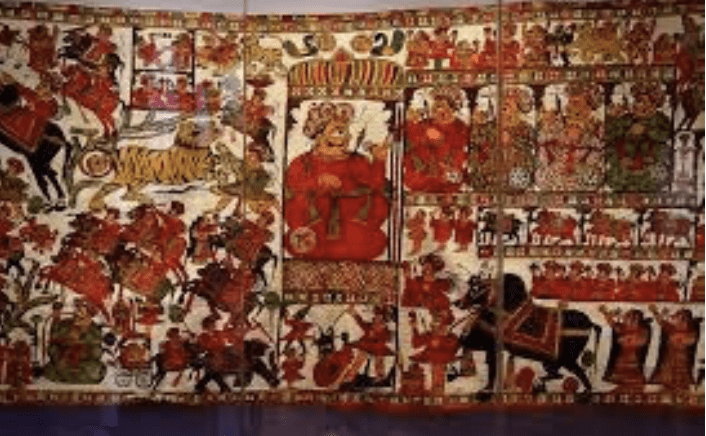
- It is a scroll-type art that is mostly seen in Rajasthan.
- It is religious in nature, with depictions of local deities such as Pabuji and Devnarayan.
- They are 15 feet or 30 feet long and painted with vegetable colors on a long piece of cloth called phad.
- The subjects have round features and wide eyes.
- They often feature pompous and cheerful narratives, as well as scenes of the procession.